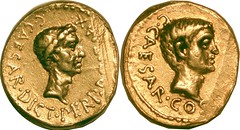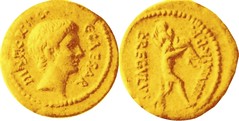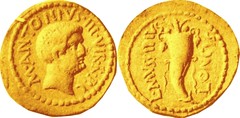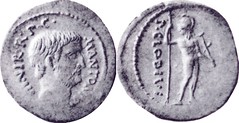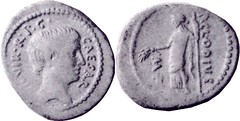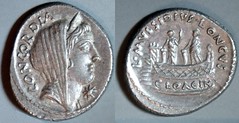Part 17 RRC 483 to RRC 497, 43BC to 41BC, Second Triumvirate of Octavian and Mark Antony, Sextus Pompeius

|
Specialist Supplements:
1. Roman Coins of Luceria and Canusium
2. Anonymous Struck Bronze Coins of the Roman Republic
3. Anonymous Roman Republican Denarii and Victoriati (Steve Brinkman's site)
Principal Coins of the Roman Republic
Part 17 RRC 483 to RRC 497, 43BC to 41BC, Second Triumvirate of Octavian and Mark Antony, Sextus Pompeius
RRC 483 Q.NASIDIVS Sextus Pompey, Nasidia C:44BC to 43BC, W:42BC to 38BC, C:moving with Sextus Pompey, W:Sicily denarius.
While I normally defer to Woytek's views on Imperatorial coinage I can hardly accept that this small
and homogenous issue was produced over an extended timescale.
RRC 484 C.ANTONIVS Caius Antony 43BC moving with Caius Antony denarius.
A very rare type.
RRC 483 Q.NASIDIVS Sextus Pompey, Nasidia C:44BC to 43BC, W:42 to 38BC, C:moving with Sextus Pompey, W:Sicily denarius. This photo pairs the obverse of NAC63 lot 467 (RBW collection, which coin was a hybrid combining the obverse of RRC 483/1 Pompey's head to left, with a reverse of RRC 483/2), along with a reverse of 483/1 (four ships type) from the Capitoline museum display case. Thus both illustrated coins, obverse and reverse, are correct dies for RRC 483/1.
RRC 485 L.FLAMIN CHILO Julius Caesar, Flaminia C:43BC, W:41BC, Rome denarii.
Woytek proposes to swap the 43BC, RRC 485 to RRC 487, Rome issues with the 41BC, RRC 512 to RRC 515, Rome issues,
thus bringing the RRC 515 type showing Brutus's portrait into a time when it would still have been
relevant to the politics of the day. The two scholars, Woytek and Crawford, are not aligned on this, and Crawford
explains his wish to leave the dating unchanged in his 2012 review of Woytek's Arma et Nummi.
RRC 486 P.ACCOLEIVS Accoleia C:43BC, W:41BC, Rome denarius.
RRC 487 PETTILIVS Petillia C:43BC, W:41BC, Rome denarius.
RRC 485 L.FLAMIN CHILO Julius Caesar, Flaminia C:43BC, W:41BC, Rome denarius.
Davis coll. A magnificant portrait of Julius Caesar.
RRC 487 PETTILIVS Petillia C:43BC, W:41BC, Rome denarius.
Davis coll. Look at the pediment details on the temple. There are two obverse styles, in this type the
thunderbolt is angled, and in the type below the thunderbolt is horizontal.
RRC 487 PETTILIVS Petillia C:43BC, W:41BC, Rome denarius.
RRC 488 M.ANTON IMP C.CAESAR DIC Mark Antony, Julius Caesar C:43BC, W:end 43BC, C:Transalpine and Cisalpine Gaul W:Cisalpine Gaul denarii.
Crawford suggests RRC 488/1, without the title R.P.C, was issued by Antony when in Gaul prior to November 43BC, and RRC 488/2,
with R.P.C, was struck after the Bononia conference with Octavian and Lepidus, on November 26th, which
formally established the second triumvirate. Woytek considers the entire issue postdates the Bononia conference.
IIIVIR RPC stands for Triumvir Reipublicae Constituendae, or
One of Three Men for the Regulation of the Republic
RRC 489/3/4/5/6 M.ANTONI M.LEPID Mark Antony, Lepidus, Fulvia 43BC to 42BC C:Transalpine and Cisalpine Gaul W:Transalpine Gaul and Lugdunum quinarii. Crawford says the issue belongs to the period from 30 May 43BC, when Antony allied with Lepidus, and early 42BC, after the triumvirate was put in place. On RRC 489/5 with Fulvia's portrait, A XL refers to Antony being 40 years old, thus pre-dates 14 January 42BC; On RRC 489/6, the date reads A XLI and must post-date 14 January 42BC. Woytek's dating is in agreement, placing RRC 489/1 through 498/5 in 43BC, and RRC 489/6 after Antony's birthday in 42BC. On a comparable issue that shows an Imperator's age, Caesar's RRC 452 with age LII 52, Crawford notes that for consistency with this RRC 489 issue where the meaning of A XL and A XLI can hardly be in doubt, the numbers must represent age achieved (after 52nd birthday) rather than 52nd year. Woytek places the RRC 489/1/2/3/4 denarii and quinarii without portrait in Transalpine Gaul (in agreement with Crawford) and the types with Fulvia's portrait in Lugdunum (whereas Crawford believes it would have followed Antony to the Bononia conference). Click photo to enlarge.
RRC 490 C.CAESAR Octavian 43BC, Cisalpine Gaul and Italy denarius.
RRC 491 L.CESTIVS C.NORBANA Cestia, Norbana 43BC, Rome aureus.
RRC 494/23 P.CLODIVS Clodia 42BC, Rome denarius.
RRC 494/24 L.LIVINEIVS Livineia, Julius Caesar 42BC, Rome denarius.
The portrait on RRC 494/24 is one of Caesar's best. It hardly escapes notice that the most attractive portraits
post-date his assassination, and may include some artistic licence.
RRC 490 C.CAESAR Octavian, Julius Caesar 43BC, Cisalpine Gaul and Italy aureus.
This is the only portrait in gold of Julius Caesar.
RRC 493 C.CAESAR M.ANTON Octavian, Mark Antony 43BC, Cisalpine Gaul aureus.
494/3/7/14 Octavian, Lepidus, Mark Antony with Mussida and Vibia 42BC, Rome aurei. This is a sample of the Triumviral portrait gold of 42BC, all so rare that it is practically impossible for any private collection or museum to form a complete collection, although that of the British Museum is quite comprehensive. T.V. Buttrey has published a monograph on the series, "The Triumviral Portrait Gold of the Quattuorviri Monetales of 42BC".
RRC 494/16/17/19 P.CLODIVS, M.ANTON, CAESAR, Julius Caesar, Mark Antony, Octavian, Clodia 42BC Rome denarii. The issues of Publius Clodius with potraits of Julius Caesar, Mark Antony and Octavian, are all very rare with no examples in the Ahala Collection.
RRC 494/25 L.LIVINEIVS C.CAESAR Octavian, Livineia 42BC, Rome denarius.
RRC 494/27/28/29 L.LIVINEIVS Livineia 42BC, Rome denarii.
It's unclear why, in a period where portraits of the triumvirs often appeared on the coins, Lucius Livineius Regulus chose to
show a portrait of an uncertain ancestor.
RRC 494/30/31 L.LIVINEIVS Livineia 42BC, Rome denarii.
RRC 494/32/36 C.VIBIVS VARVS Mark Antony, Vibia 42BC, Rome denarii.
RRC 494/37,38 C.VIBIVS VARVS Mark Antony, Vibia 42BC, Rome denarii.
RRC 494/39 L.MVSSIDIVS LONGVS Julius Caesar, Mussidia 42BC, Rome denarius.
RRC 495 LEPIDVS CAESAR Octavian Lepidus C:42BC, W:end 43BC, Italy denarius.
These are terrific portraits of Lepidus and Octavian on an issue that is generally poorly produced.
RRC 494/41/42/43 L.MVSSIDIVS LONGVS Mussidia 42BC, Rome denarii. Davis coll.
RRC 496/1/2/3 M.ANTONIVS Mark Antony 42BC, moving with Antony denarii.
All the RRC 496 Mark Antony types have the sun-god Sol on their reverses. Woytek suggests that RRC 496/1/2
which are of a common compact, neat style, were minted in Italy before July 42BC, and RRC 496/3, on broad irregular
flans with coarser engraving, was minted in Greece between July and September 42BC.
RRC 497 C.CAESAR Octavian 42BC, moving with Octavian denarius.
RRC 497 CAESAR Octavian 42BC, moving with Octavian denarius.
Specialist Supplements:
1. Roman Coins of Luceria and Canusium
2. Anonymous Struck Bronze Coins of the Roman Republic
3. Anonymous Roman Republican Denarii and Victoriati (Steve Brinkman's site)
All content copyright © 2004-2013 Andrew McCabe unless otherwise noted. If you've any questions or comments please contact me on the Yahoo Group RROME: http://groups.yahoo.com/group/RROME.
Alternately you can leave comments against any coin picture, just click on the picture and write in the comment box.
Site hosted free courtesy of VCoins.com
Ancient Coins on Vcoins
comment: this page is RRC483.html














